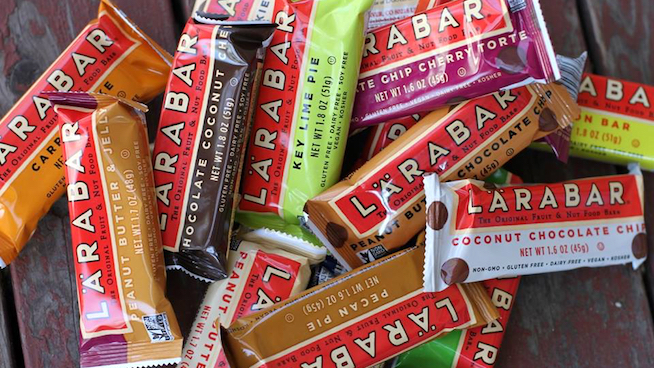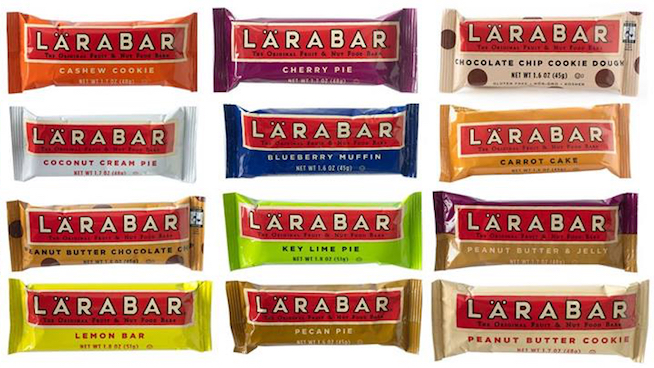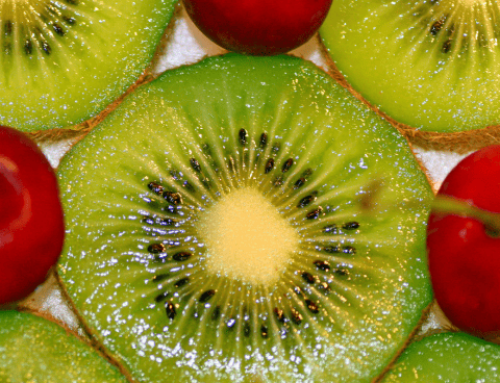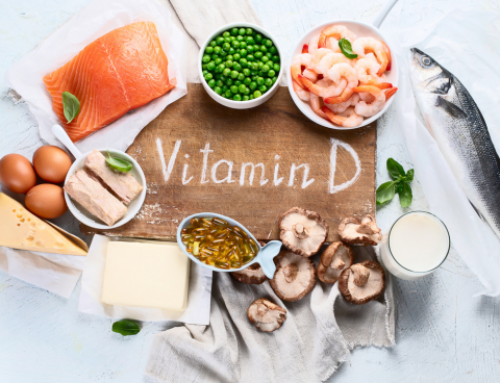Are Lärabars Actually Healthy?
While a new wellness bar brand now seems to appear on the shelves every other day, Lärabars have been around for over 15 years. Throughout that time, they’ve enjoyed a reputation as one of the healthiest packaged snacks around. But is it deserved? Are Lärabars truly as healthy as most people think? Let’s dive into the nutrition facts of this wildly popular bar and get to the bottom of that question.

Photo via Larabar on Facebook
One of the most attractive elements of Lärabars is their relative simplicity. The company likes to tout that each bar is made with between 2-9 ingredients that are all “recognizable” and “minimally processed.” There might be relatively few ingredients in each variety, but there are a whole lot of different varieties—I count nearly 40 across the company’s “Original,” “Organic With Superfoods,” “Fruits + Greens” and “Protein” Lärabar lines. Most have similar enough nutrition facts, but for the sake of keeping this piece semi-focused, let’s hone in on the nutrition for the five top-rated Lärabar varieties on Ranker—Peanut Butter & Chocolate Chip, Chocolate Chip Cookie Dough, Peanut Butter Cookie, Chocolate Chip Brownie and Banana Bread.
Combining the nutrition facts for those five bars together, you get an average (per bar) of:
- 206 Calories
- 10.8 Grams of Fat
- 2.2 Grams of Saturated Fat
- 47 Milligrams of Sodium
- 24.2 Total Carbohydrate
- 3.4 Grams Dietary Fiber
- 17.2 Grams of Sugar
- 2.2 Grams of Added Sugar
- 4.6 Grams of Protein
- 5 Ingredients
The straightforward recipes make it easy to trace where these totals come from. Dates are the No. 1 ingredient in three of the varieties, and the second ingredient in the other two. Much of Lärabars’ sugar and fiber content comes from dates.
According to the National Institutes of Health, teens and adults should eat between 20 and 38 grams of fiber each day, and men need more fiber than women. But the average American consumes just 10 to 15 grams of fiber daily. Fiber helps break down foods for easier digestion, maintains good bowel health, lowers cholesterol levels and helps you feel fuller longer. High-fiber diets have been linked to positive outcomes such as a reduced risk of diabetes and heart disease. In the short term, snacking on a bar high in fiber can help you feel fuller for longer and avoid a rapid spike and crash in blood sugar. In the long term, it could reduce your risk of many major diseases and supports good bowel health. Dates are a good source of fiber, as one pitted deglet noor date contains 0.6 grams. They’re also a potent source of flavonoids, carotenoids and phenolic acid—all important antioxidants that can help keep you healthy.
However, dates—and in particular, dried dates, such as those typically used in this sort of product—are also high in sugar. One pitted deglet noor date contains 4.5 grams. Lärabars are not low in sugar, with many varieties coming in at or above 17 grams per bar. That’s only a hair less than you’d find in a serving of Milk Duds. However, while the sugar in candy is essentially all of the added variety, that’s not the case with Lärabars. The majority of that sugar is coming from those dates, and by being bundled with fiber and a number of other healthful nutrients, its impact on our bodies is much less harmful.
“Fiber slows down digestion, resulting in the sugar being absorbed more slowly,” says Brian St. Pierre, nutrition coach at Precision Nutrition. This gives your liver more time to metabolize the sugar, which keeps your blood sugar relatively stable. A 2018 study published in the journal Nutrition and Diabetes found that “people with diabetes and followers of diets based on the glycemic index (GI) can enjoy dried fruits knowing they do not cause a blood sugar spike compared to starchy foods such as white bread.”
Don’t mistake the naturally-occurring sugar from a food like dates as being the same as the refined sugar food manufacturers add to cookies, candies, soda, etc. That thinking unfairly demonizes many fruits when our bodies actually handle these types of sugars totally differently for a multitude of reasons. However, certain varieties of Lärabars do also contain some added sugar—which we’ll get into more later.
In terms of fat, roughly 11 grams per bar is a significant amount. However, much of it qualifies as “healthy” fat. That’s largely because Lärabars make extensive use of ingredients like peanuts, cashews, almonds and walnuts. Nuts (peanuts are technically legumes but have a nutritional profile similar to most nuts) are high in monounsaturated and polyunsaturated fats. Monounsaturated fats help reduce blood pressure and protect against heart disease. They can also help the body better absorb vitamins and more efficiently use protein. Polyunsaturated fats can reduce blood cholesterol levels and lower the risk of heart disease and strokes. The best way to reap the benefits of monounsaturated and polyunsaturated fats is to use them to replace saturated fats in your diet.
Speaking of saturated fats, most Lärabars contain 1-3 grams of saturated fat. That’s not nothing, but it’s much less than you’d find in your typical candy bar. Eating too much saturated fat drastically increases your risk of high cholesterol, which in turn can have a negative impact on blood flow and oxygen transportation throughout the body. The American Heart Association recommends that no more than 6% of your daily calories come from saturated fat. For a 2,000-calories-a-day diet, that translates to a limit of 13 grams of saturated fat each day.
Then there’s protein. While the “Protein” line of Lärabars contain 11 grams of protein per bar, most original varieties contain between 3-6 grams per bar. Protein is a critical nutrient for humans and athletes, in particular. High-quality protein provides the amino acids muscles need to repair and rebuild, allowing you to recover from exercise and get stronger over time. The body can also use protein as a source of energy and meals or snacks high in protein can help corral your appetite. The protein found in Lärabars largely comes from the significant amount of nuts included in the recipes.
Overall, a Lärabar can be a fairly nutritious snack. When eaten adjacent to or during exercise (such as hiking), a Lärabar can help keep your working muscles fueled with carbohydrate. In most cases, it’s basically akin to eating a handful of nuts and dates.

Photo via Larabar on Facebook
However, problems can quickly arise when you’re downing 2-3 Lärabars a day—a common habit among those who use the bars as a meal replacement. Using a wellness bar to replace a well-balanced meal of whole foods is rarely a wise decision. You’ll often get less nutrients and feel less full (partially due to eating such a smaller total volume of food), leaving you subject to greater amounts of snacking. And this is where that added sugar I mentioned earlier can come back to bite you.
Some varieties of Lärabar contain 0 grams of added sugar, while others contain up to 4 grams. The varieties highest in added sugar tend to include chocolate chips in their recipe. Down two bars of a variety that contains 4 grams of added sugar per bar (such as Coconut Chocolate Chip or Chocolate Chip Brownie), and that’s 8 grams of added sugar in a sitting. Added sugar is perhaps the biggest driver of America’s obesity epidemic, and there’s no need for them in our diet. The American Heart Association recommends a maximum amount of added sugar per day of no more than 25 grams for women and 37.5 grams for men. So with the wrong variety, that Lärabar lunch could count a quick 8 grams against that total. Then you’ve got the people who reason that they only had Lärabars for lunch, so they can splurge the rest of the day. A soda and a dessert later, and you’re well beyond the recommended limit for added sugar.
The product is marketed as a snack, not a meal replacement, but I only write about it because people do it. If you’re a Lärabar fanatic who’s downing five or more bars a week, it’s worth looking into the nutrition facts of the different varieties. Differences that may seem rather trivial at a glance can quickly add up if you’re eating 1-2 bars a day. A simple checklist to remember is that you want the options higher in fiber and protein, yet lower in added sugar and saturated fat. For example, Peanut Butter Banana variety packs 4 grams of fiber and 5 grams of protein, yet just 1.5 grams of saturated fat and zero grams of added sugar. On the flip side, Coconut Chocolate Chip has 3 fewer grams of protein, but 4 more grams of added sugar and 4.5 more grams of saturated fat.
Lärabars are a solid nutritional choice. Varieties like Cashew Cookie contain just two recognizable ingredients—dates and cashews. However, it’s still possible to overdo it on them, particularly if you’re gravitating towards the less-healthy varieties. Be smart about it and Lärabars can absolutely fit into a healthy diet.
Photo Credit: Larabar on Facebook
READ MORE:
RECOMMENDED FOR YOU
MOST POPULAR
Are Lärabars Actually Healthy?
While a new wellness bar brand now seems to appear on the shelves every other day, Lärabars have been around for over 15 years. Throughout that time, they’ve enjoyed a reputation as one of the healthiest packaged snacks around. But is it deserved? Are Lärabars truly as healthy as most people think? Let’s dive into the nutrition facts of this wildly popular bar and get to the bottom of that question.

Photo via Larabar on Facebook
One of the most attractive elements of Lärabars is their relative simplicity. The company likes to tout that each bar is made with between 2-9 ingredients that are all “recognizable” and “minimally processed.” There might be relatively few ingredients in each variety, but there are a whole lot of different varieties—I count nearly 40 across the company’s “Original,” “Organic With Superfoods,” “Fruits + Greens” and “Protein” Lärabar lines. Most have similar enough nutrition facts, but for the sake of keeping this piece semi-focused, let’s hone in on the nutrition for the five top-rated Lärabar varieties on Ranker—Peanut Butter & Chocolate Chip, Chocolate Chip Cookie Dough, Peanut Butter Cookie, Chocolate Chip Brownie and Banana Bread.
Combining the nutrition facts for those five bars together, you get an average (per bar) of:
- 206 Calories
- 10.8 Grams of Fat
- 2.2 Grams of Saturated Fat
- 47 Milligrams of Sodium
- 24.2 Total Carbohydrate
- 3.4 Grams Dietary Fiber
- 17.2 Grams of Sugar
- 2.2 Grams of Added Sugar
- 4.6 Grams of Protein
- 5 Ingredients
The straightforward recipes make it easy to trace where these totals come from. Dates are the No. 1 ingredient in three of the varieties, and the second ingredient in the other two. Much of Lärabars’ sugar and fiber content comes from dates.
According to the National Institutes of Health, teens and adults should eat between 20 and 38 grams of fiber each day, and men need more fiber than women. But the average American consumes just 10 to 15 grams of fiber daily. Fiber helps break down foods for easier digestion, maintains good bowel health, lowers cholesterol levels and helps you feel fuller longer. High-fiber diets have been linked to positive outcomes such as a reduced risk of diabetes and heart disease. In the short term, snacking on a bar high in fiber can help you feel fuller for longer and avoid a rapid spike and crash in blood sugar. In the long term, it could reduce your risk of many major diseases and supports good bowel health. Dates are a good source of fiber, as one pitted deglet noor date contains 0.6 grams. They’re also a potent source of flavonoids, carotenoids and phenolic acid—all important antioxidants that can help keep you healthy.
However, dates—and in particular, dried dates, such as those typically used in this sort of product—are also high in sugar. One pitted deglet noor date contains 4.5 grams. Lärabars are not low in sugar, with many varieties coming in at or above 17 grams per bar. That’s only a hair less than you’d find in a serving of Milk Duds. However, while the sugar in candy is essentially all of the added variety, that’s not the case with Lärabars. The majority of that sugar is coming from those dates, and by being bundled with fiber and a number of other healthful nutrients, its impact on our bodies is much less harmful.
“Fiber slows down digestion, resulting in the sugar being absorbed more slowly,” says Brian St. Pierre, nutrition coach at Precision Nutrition. This gives your liver more time to metabolize the sugar, which keeps your blood sugar relatively stable. A 2018 study published in the journal Nutrition and Diabetes found that “people with diabetes and followers of diets based on the glycemic index (GI) can enjoy dried fruits knowing they do not cause a blood sugar spike compared to starchy foods such as white bread.”
Don’t mistake the naturally-occurring sugar from a food like dates as being the same as the refined sugar food manufacturers add to cookies, candies, soda, etc. That thinking unfairly demonizes many fruits when our bodies actually handle these types of sugars totally differently for a multitude of reasons. However, certain varieties of Lärabars do also contain some added sugar—which we’ll get into more later.
In terms of fat, roughly 11 grams per bar is a significant amount. However, much of it qualifies as “healthy” fat. That’s largely because Lärabars make extensive use of ingredients like peanuts, cashews, almonds and walnuts. Nuts (peanuts are technically legumes but have a nutritional profile similar to most nuts) are high in monounsaturated and polyunsaturated fats. Monounsaturated fats help reduce blood pressure and protect against heart disease. They can also help the body better absorb vitamins and more efficiently use protein. Polyunsaturated fats can reduce blood cholesterol levels and lower the risk of heart disease and strokes. The best way to reap the benefits of monounsaturated and polyunsaturated fats is to use them to replace saturated fats in your diet.
Speaking of saturated fats, most Lärabars contain 1-3 grams of saturated fat. That’s not nothing, but it’s much less than you’d find in your typical candy bar. Eating too much saturated fat drastically increases your risk of high cholesterol, which in turn can have a negative impact on blood flow and oxygen transportation throughout the body. The American Heart Association recommends that no more than 6% of your daily calories come from saturated fat. For a 2,000-calories-a-day diet, that translates to a limit of 13 grams of saturated fat each day.
Then there’s protein. While the “Protein” line of Lärabars contain 11 grams of protein per bar, most original varieties contain between 3-6 grams per bar. Protein is a critical nutrient for humans and athletes, in particular. High-quality protein provides the amino acids muscles need to repair and rebuild, allowing you to recover from exercise and get stronger over time. The body can also use protein as a source of energy and meals or snacks high in protein can help corral your appetite. The protein found in Lärabars largely comes from the significant amount of nuts included in the recipes.
Overall, a Lärabar can be a fairly nutritious snack. When eaten adjacent to or during exercise (such as hiking), a Lärabar can help keep your working muscles fueled with carbohydrate. In most cases, it’s basically akin to eating a handful of nuts and dates.

Photo via Larabar on Facebook
However, problems can quickly arise when you’re downing 2-3 Lärabars a day—a common habit among those who use the bars as a meal replacement. Using a wellness bar to replace a well-balanced meal of whole foods is rarely a wise decision. You’ll often get less nutrients and feel less full (partially due to eating such a smaller total volume of food), leaving you subject to greater amounts of snacking. And this is where that added sugar I mentioned earlier can come back to bite you.
Some varieties of Lärabar contain 0 grams of added sugar, while others contain up to 4 grams. The varieties highest in added sugar tend to include chocolate chips in their recipe. Down two bars of a variety that contains 4 grams of added sugar per bar (such as Coconut Chocolate Chip or Chocolate Chip Brownie), and that’s 8 grams of added sugar in a sitting. Added sugar is perhaps the biggest driver of America’s obesity epidemic, and there’s no need for them in our diet. The American Heart Association recommends a maximum amount of added sugar per day of no more than 25 grams for women and 37.5 grams for men. So with the wrong variety, that Lärabar lunch could count a quick 8 grams against that total. Then you’ve got the people who reason that they only had Lärabars for lunch, so they can splurge the rest of the day. A soda and a dessert later, and you’re well beyond the recommended limit for added sugar.
The product is marketed as a snack, not a meal replacement, but I only write about it because people do it. If you’re a Lärabar fanatic who’s downing five or more bars a week, it’s worth looking into the nutrition facts of the different varieties. Differences that may seem rather trivial at a glance can quickly add up if you’re eating 1-2 bars a day. A simple checklist to remember is that you want the options higher in fiber and protein, yet lower in added sugar and saturated fat. For example, Peanut Butter Banana variety packs 4 grams of fiber and 5 grams of protein, yet just 1.5 grams of saturated fat and zero grams of added sugar. On the flip side, Coconut Chocolate Chip has 3 fewer grams of protein, but 4 more grams of added sugar and 4.5 more grams of saturated fat.
Lärabars are a solid nutritional choice. Varieties like Cashew Cookie contain just two recognizable ingredients—dates and cashews. However, it’s still possible to overdo it on them, particularly if you’re gravitating towards the less-healthy varieties. Be smart about it and Lärabars can absolutely fit into a healthy diet.
Photo Credit: Larabar on Facebook
READ MORE:











